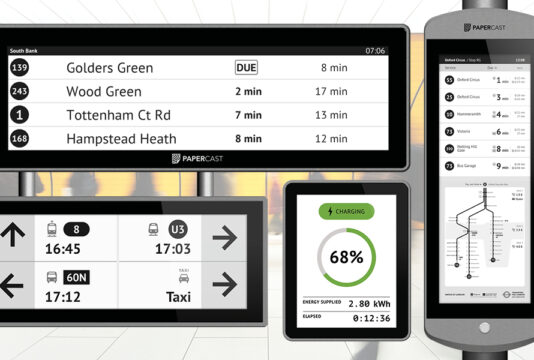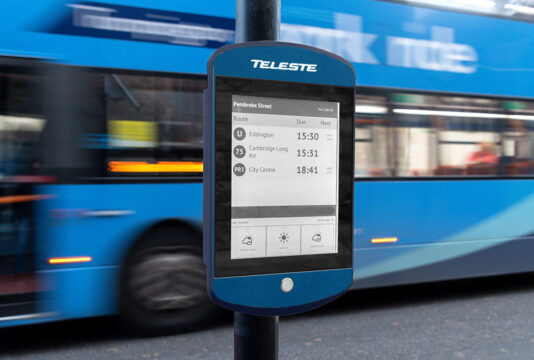When we hear the term electronic paper displays, the majority of us think e-readers.

Since Amazon launched the Kindle in 2007, the e-paper display market has exploded with growth estimated at 40% CAGR to 2020. While e-readers currently lead the segment with a market share of 54.84%, much of the forecasted growth is expected to come from other applications.

Electronic paper displays are incredibly versatile, and if you haven’t already seen its wider application, it won’t be long before you do! We are seeing e-paper used in anything from consumer electronics, wearables and white goods (such as watches, MP3 players, fitness devices, microwaves and clothing) to retail environments (such as shelf labels, price tags, promotions, posters and smart packaging) and medical devices.

Another booming application is in digital signage, and this is what I will delve into in this blog.
But firstly…
What is electronic paper?
Wikipedia offers a straightforward description:
Electronic paper and e-paper are display devices that mimic the appearance of ordinary ink on paper. Unlike conventional backlit flat panel displays that emit light, electronic paper displays reflect light like paper.
E-paper takes the best elements of the printed page and merges it with electronics to create a new generation of paper: a low power, instantly updateable paper, readable even in the brightest sunlight.
How the e-paper display works and what makes it so special
There are several components to explore and I won’t go into too much detail as there are plenty of detailed resources on the internet about this. But in a nutshell, the display combines three unique qualities: the e-ink system, bistable technology and a reflective display.
- At the very core of e-ink technology are microcapsules filled with a clear fluid containing tiny pigment particles. The particles are under the influence of an electric field and rearranged to make the surface of the e-paper display appear a certain colour. Each display is made up of millions of capsules. Watch this video:
- Power is required to put the particles in place, and they won’t move until the next electric charge rearranges them into another pattern. This is called bistable, and I want to be very clear about this: it takes no power at all to display an image and only a little power to change an image. This makes electronic paper one of the lowest power display technologies in the world (in contrast, LCD screens need refreshing around 30-times per second!).
- An e-paper display is also ‘reflective’, meaning that it will feature the same readability as traditional paper (in contrast, LCD screens are ‘emissive’ where a backlight illuminates pixels). This feature makes e-paper displays easier on the eyes, provides a wider viewing angle and makes content perfectly visible even in direct sunlight.
Why the move to digital signage?
The digital signage market is on an upwards trajectory. In fact, the market was valued at USD 16.88 Billion in 2015 and is expected to achieve a CAGR of 6.7% between 2016 and 2022. This growth is attributable to both the many benefits of delivering content digitally, as well as production innovations that have led to considerable cost reductions.
So what are those many benefits? In a nutshell, digital signage is dynamic, speedy and inexpensive compared to conventional static signage. It is ideal for firms that want to more effectively engage their audience, improve the user experience and get targeted messages to customers on time.
While indoor applications still represent 80% of the market, the use of outdoor signage is picking up. Of course, this isn’t a new concept – think London’s West End, Times Square, Toykyo and other big city environments – but we are increasingly seeing other forms of digital technology making its way outdoors, with a variety of purposes and in a variety of formats.
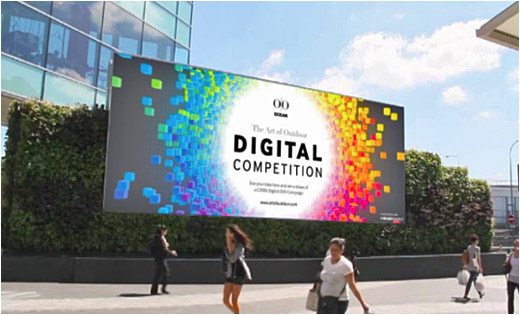
Electronic billboards along roadsides, digital posters along high streets and screens used in stations are now becoming commonplace. We are about to witness a boom in other applications.
Why e-paper is the perfect digital signage platform
Original outdoor digital signage used cathode ray tubes (CRTs) before progressing on to liquid crystal displays (LCDs). LCDs present various challenges and the most notable is poor visibility in sunlight. Not only does this impact the effectiveness of the display, it has to compete with the sun and draw a massive amount of energy (and therefore dedicated high power) to put out a great deal of light to compensate. This is a major drawback for LCD technology in outdoor environments.
The most widely used technology in outdoor signage is light-emitting diodes (LED), and now we are experiencing the emergence of e-paper technology. We know how e-paper delivers incredibly low power consumption and high screen visibility, and it is these extraordinary characteristics make e-paper perfect for outdoor public information displays.
Here’s a quick look at e-paper advantages compared to current alternative display technologies:
| LED (Light Emitting Diodes)
* Dominates the market |
LCD (Liquid Crystal Displays)
* Smaller share, second to LED |
E-paper
* Emerging and gaining pace |
| + Full colour illumination
– Harder on the eyes – No high-definition content – Can’t display video – High power demands – No content without power + Easy to read outdoors + Light-emitting, so you can read in the dark – Pixel based, hard to read in close proximity + Can withstand the extremes of weather – The technology relatively heavy |
+ Full colour
– Harder on the eyes + Displays high-definition content + Can display video – High power demands – No content without power – Hard to read in sunlight + Backlit, so you can read in the dark – Pixilation when scaled – Complicated temperature maintenance requirements – Weighs around 3-times more than e-paper |
– High contrast monochrome
+ Easy on the eyes, just like paper + Displays high-definition content – Can’t display video + Ultra low power + Shows content without power + Easy to read outdoors + Can be read in the dark with illumination + Very crisp and sharp + Can withstand the extremes of weather + It is incredibly light-weight |
As you can see e-paper boasts many benefits over the alternatives, making it impeccably well suited to long-term outdoor use in specific applications (the inability to display video wouldn’t make it well suited to advertising billboards, for example). The potential is staggering, and so it probably comes as no surprise that e-paper is starting to penetrate the transport sector.
Why transport operators are making a move to e-paper for RTPI signage
We are seeing more and more cities around the world introduce new electronic paper displays to city centre bus stops, providing timely and accurate service information to passengers. The benefits are plentiful:
- The display can be seen in the reflection from direct sunlight, offering better visibility than ordinary signage.
- Because the display runs on very low energy, it is entirely solar powered in all climates, making it extremely cost-efficient and environmentally friendly to operate.
- It connects to the management system using wireless technologies, so that it can be easily installed completely ‘off-the-grid’.
- Content can be changed instantly and effortlessly by control centres, removing the need for constantly changing paper timetables.
In addition to bus schedules, the electronic paper displays can also show exact bus arrival times and passenger information, such as notifications about line detours or new routes. City news and updates about various events and nearby tourist information can also be displayed.
Papercast has developed one of the most advanced platforms on the market
Papercast is a leader in solar powered e-paper RTPI display systems. Our technology offers a distinctive combination of features, making the platform one of the most advanced solutions of its kind available on the market today.
With the leading design principle of exceptionally low energy consumption, we have developed Papercast’s e-paper display to deliver a far superior experience in a stand-alone solar-powered unit that can be installed literally anywhere, in hours. It offers an extremely economical replacement for legacy electronic systems and traditional paper timetables, while providing the ideal technology platform for smart city public transport information solutions.
Bus operators can expect to achieve the following by installing Papercast’s e-paper based passenger information systems:
- Reduce Operating Costs – Reduce costs and environmental impact by replacing legacy LCD with energy efficient e-paper (36 times more efficient).
- Technology Refresh – Next generation platform for planned technology refresh, meets changing needs and mitigates the risk of obsolescence.
- Smart City Solution – Ideal passenger information technology platform to optimise the use of public transport in smart city strategies.
- Better Customer Experience – Provide more informative content on sophisticated colour and monotone high-resolution e-paper displays, available in different sizes.
- Improve Passenger Confidence – Deliver accurate service information to all bus stops across the network, even in the most remote locations.
- Eliminate Paper Content – No need to manually replace paper-based bus stop content, which out dates quickly and doesn’t always reflect the excepted service.
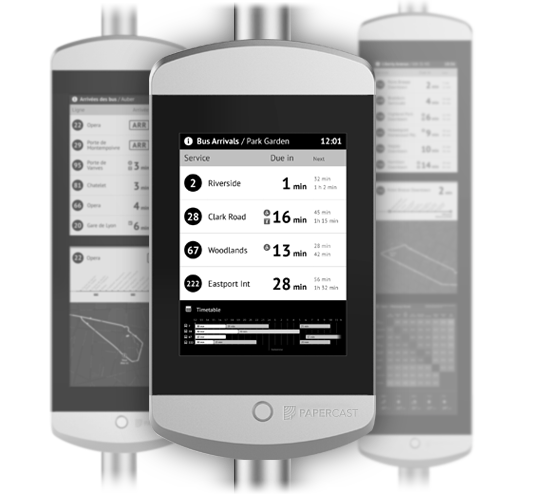
Passengers will be more informed than ever before
Papercast’s e-paper displays form part of a next generation RTPI technology platform undergoing significant investment and enhancement:
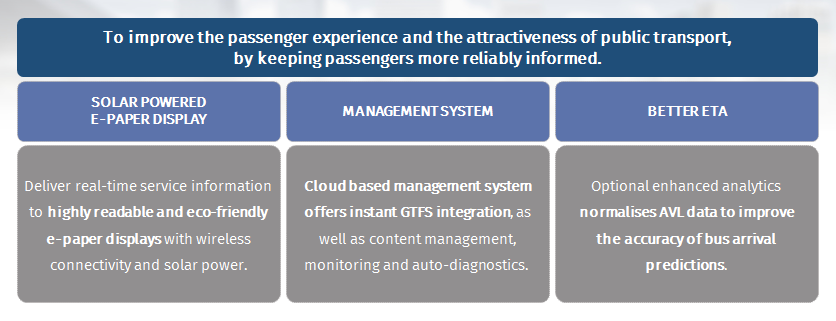
Our e-paper display boasts the following characteristics:
- E-Paper Characteristics – High brightness, high contrast, no glare, 180 degree viewing angle and low power usage, illuminated by front light in the dark.
- Solar Powered – The display is optimised for solar power from panels installed on the bus stop.
- Integral Connectivity – Highly compressed data transfer with multiple communication options including 3G, 4G, Wi-Fi, LAN and TETRA.
- Display Options – Available in both colour and mono-tone and with 9”, 13” and 32” screen sizes, ability to combine two, three or more displays into a larger screen.
- Information Refresh – Local and partial update, minimising flicker, reducing connectivity and power usage, improving the user experience.
- Weather and Vandalism Proof – The display is enclosed in a ruggedized, weather and UV resistant, anti-vandalism casing, with integrated accelerometer.
- Monitoring and Diagnostics – Built-in telemetry enables proactive maintenance including solar panel cleaning, battery replacement and so on.
- Easy to Install – It can be deployed on a modular basis and mounted on any surface, wall or pole, without the need for any civils work.
- Easily Integrated – Designed for easy system integration, built on an open development platform compliant with all content standards, supporting standards such as GTFS and SIRI.
Do you need to improve the customer experience and keep your passengers more informed? Are you progressing to smart technologies for passenger information? Would you like to understand how Papercast’s technology has surpassed all other e-paper platforms?
“Working with you to improve customer experience and overall utilisation of public transport by keeping passengers more reliably informed, by helping as many service providers as possible to transition to next generation technologies”


